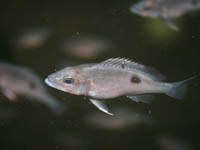NGI Research Highlight: Red Snapper
July 9, 2012

Northern Gulf Institute researcher Dr. Paula Moreno (USM) is investigating how the distribution of juvenile red snapper is related to shrimp fishing effort. The overfished red snapper is one of the most important commercial and recreational species in the Gulf of Mexico. The commercial shrimp fishery is one of the main sources of juvenile red snapper mortality leading to recent provisions which authorize seasonal area closures to shrimping if red snapper by-catch reduction targets are not met.
Dr. Moreno examined fishery-independent Southeast Area Monitoring and Assessment Program data and the Electronic Log Book data collected aboard shrimp vessels to locate high-density areas of juvenile red snapper not intensively shrimped. Minimizing disruption to the shrimp fishery caused by closures while maximizing survival of juvenile red snapper may be accomplished by identifying important red snapper nursery habitat with low intensity of shrimping. This knowledge will protect nursery habitat, while minimizing disruption to the shrimp fishery.

Preliminary results suggest that despite the overall Gulf of Mexico decline in shrimp fishing effort, high levels of shrimping effort are associated with a decrease in relative abundance of red snapper. The highest levels of juvenile red snapper and shrimp effort were widely distributed and overlap in several locations. This study indicates juvenile red snapper prefer habitat in waters 18-75m deep, while many of the highly-shrimped sites were closer to the coast. The most striking finding is an area off the TX-LA border with high density of juvenile red snapper that experienced hardly any high-level shrimp effort. If this region offers consistently good nursery conditions for red snapper, and is not among the most important shrimping areas, then it would be a good candidate to protect nursery habitat for red snapper, leading to a faster recovery of red snapper stocks.
 Northern Gulf Institute researcher Dr. Paula Moreno (USM) is investigating how the distribution of juvenile red snapper is related to shrimp fishing effort. The overfished red snapper is one of the most important commercial and recreational species in the Gulf of Mexico. The commercial shrimp fishery is one of the main sources of juvenile red snapper mortality leading to recent provisions which authorize seasonal area closures to shrimping if red snapper by-catch reduction targets are not met.
Northern Gulf Institute researcher Dr. Paula Moreno (USM) is investigating how the distribution of juvenile red snapper is related to shrimp fishing effort. The overfished red snapper is one of the most important commercial and recreational species in the Gulf of Mexico. The commercial shrimp fishery is one of the main sources of juvenile red snapper mortality leading to recent provisions which authorize seasonal area closures to shrimping if red snapper by-catch reduction targets are not met.  Preliminary results suggest that despite the overall Gulf of Mexico decline in shrimp fishing effort, high levels of shrimping effort are associated with a decrease in relative abundance of red snapper. The highest levels of juvenile red snapper and shrimp effort were widely distributed and overlap in several locations. This study indicates juvenile red snapper prefer habitat in waters 18-75m deep, while many of the highly-shrimped sites were closer to the coast. The most striking finding is an area off the TX-LA border with high density of juvenile red snapper that experienced hardly any high-level shrimp effort. If this region offers consistently good nursery conditions for red snapper, and is not among the most important shrimping areas, then it would be a good candidate to protect nursery habitat for red snapper, leading to a faster recovery of red snapper stocks.
Preliminary results suggest that despite the overall Gulf of Mexico decline in shrimp fishing effort, high levels of shrimping effort are associated with a decrease in relative abundance of red snapper. The highest levels of juvenile red snapper and shrimp effort were widely distributed and overlap in several locations. This study indicates juvenile red snapper prefer habitat in waters 18-75m deep, while many of the highly-shrimped sites were closer to the coast. The most striking finding is an area off the TX-LA border with high density of juvenile red snapper that experienced hardly any high-level shrimp effort. If this region offers consistently good nursery conditions for red snapper, and is not among the most important shrimping areas, then it would be a good candidate to protect nursery habitat for red snapper, leading to a faster recovery of red snapper stocks.